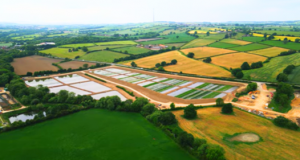Case study: Actemium’s automation expertise helps Yorkshire Water improve River Dearne’s water quality and biodiversity

When Yorkshire Water decided to create a natural wetland to treat water before it flows back into the River Dearne, Actemium’s automation engineers stepped in with their systems integration expertise. They provided the design, implementation, testing and commissioning for the new software controls needed for the pumping station’s Programmable Logic Controller (PLC) and Local Operator interface (LOI).

Project Overview
Customer: Yorkshire Water
Sector: Water and Wastewater
Location: West Yorkshire
Project Purpose: To improve water quality in the River Dearne by treating storm overflows and reducing pollutants.
Project status: Completed in summer 2025
Expertise: Control system and software integration
Scope: Advise, Design, Testing, Commissioning, Implementation, Project Management for software engineering needed for new pumping system.
Solution: PLC Controller & LOI software.
Actemium BU: Actemium Automation Yorkshire
Project Value (total scheme): £14m
Client Relationship: Long-term client
Our client & their requirements
Yorkshire Water, a long-standing customer of Actemium, is a major utility provider in the UK, delivering water and wastewater treatment services to more than 5.5 million households and 140,000 businesses across Yorkshire and Derbyshire.
To significantly improve the quality of the water in the River Dearne in West Yorkshire and enhance conditions for local wildlife, Yorkshire Water proposed the creation of a 4.3-hectare wetland at Deane Reach, complete with 13 interconnected ponds. The wetlands, populated with over 300,000 plants, aim to provide a natural solution for boosting the river’s water quality. They add a low-carbon, nature-based layer to treat storm overflow discharges from the nearby Clayton West Wastewater Treatment Works before the water is returned to the river. This nature-based approach is also intended to increase local biodiversity and resilience.
A crucial objective of the initiative was to reduce levels of un-ionised ammonia in the watercourse in adherence with the salmonid Fundamental Intermittent Standards (FISs). These standards are designed to protect aquatic ecosystems, particularly those supporting salmonid fisheries, such as salmon and trout, from the impacts of pollution from sources such as storm overflows.
Under the Yorkshire Water plan, stormwater flows would be directed to the wetlands through a new pumping station and associated infrastructure. Level sensors would ensure that treated effluent is retained within the wetlands during dry conditions to sustain plant life, while stormwater would safely pass through the wetland and discharge safely into the existing river outfall during storm events.
The Challenge
The project posed several technical and operational challenges, mainly revolving around:
- Evolving end-customer regulatory requirements relating to plant water flow.
- Maintaining communication link between the wetlands pumping station and the remote wetland instrumentation.
- Ensuring the approach aligned with regulatory requirements, whilst balancing environmental protection with operational efficiency.
The Solution
The project brought together a synergy of UK expertise, led by Mott MacDonald Bentley, a leading construction engineering firm. RSE Control Systems (TCS) provided the control panel hardware, while Actemium Automation took charge of the system integration activities.
Key features of the solution provided by Actemium include:
- Developing a detailed control system Functional Design Specification (FDS) based on Yorkshire Water’s user requirement specification and associated information.
- Designing and developing new PLC and Local Operator Interface (LOI) software to monitor and control the new wetlands pumping station and remote instrumentation as below:
- Automated water level management: An ultrasonic sensor to measure water levels, with a PID controller adjusting pump flow as needed and backup switches ensuring continuity if the ultrasonic sensor becomes unavailable.
- Dry-weather flow control: A TSR Actuated penstock automatically directing final effluent flows to the wetlands pumping station and wetland cells.
- Remote monitoring: Instrumentation monitoring the levels within the wetland cells, with the information transmitted to the pumping station’s PLC via remote communications.
- Rigorous testing: Conducting a combined panel and software customer factory acceptance test (FAT) prior to delivery to the site.
- On-site implementation of the new control system.
Client Benefits
The project has successfully met the client’s goal of creating a natural, resilient storm storage solution that enhances the water quality of the River Dearne, boosts local biodiversity, and provides a habitat to support wildlife.
From an operational perspective, the system:
- Meets the regulatory requirements needed to reduce the levels of un-ionised ammonia in the watercourse, and
- Provides automatic monitoring and adjustment of water levels.
Mike Jones, South Projects Manager at Yorkshire Wildlife Trust, said: “Schemes like this are really inspirational for other parts of the water sector – you can improve the water quality whilst also providing something for nature. This is an impressive start, and we look forward to seeing how the project develops, continuing to play a part in collaboration, further improving the outcomes for nature and water management in a changing climate.”
Ben Gouldsborough, Project Manager at Yorkshire Water, stated: “I live locally, and it’s been a joy to drive down and see the project change over the duration of the scheme from a field to a wetland filled with plants. I’m personally excited to see it grow, have the plants bloom, and ultimately, see the river Dearne benefit.”
To discover more, watch this video from Yorkshire Water.
Future plans
A second initiative is underway at Clayton West treatment works — a £4.9m project aimed at reducing the phosphorous levels in the wastewater returned to the river post-treatment. Upon completion, this project will enhance the water quality of more than 3.7km of the watercourse downstream of the treatment works. This effort is part of a broader initiative to improve approximately 56km of the River Dearne’s catchment area through various phosphorous reduction schemes.
Need an automation expert to support your next water project?
We have over 35 years of experience supporting water and wastewater projects for companies across the UK. To speak to our engineers about your project, get in touch via reachout@actemium.co.uk.
